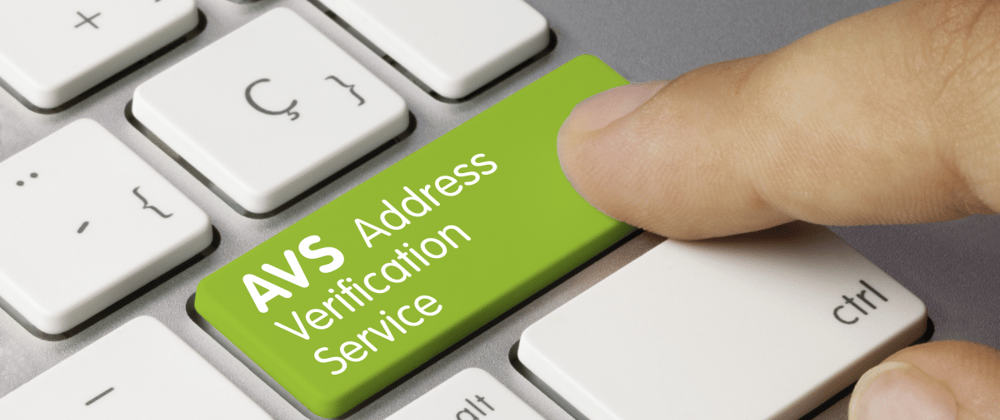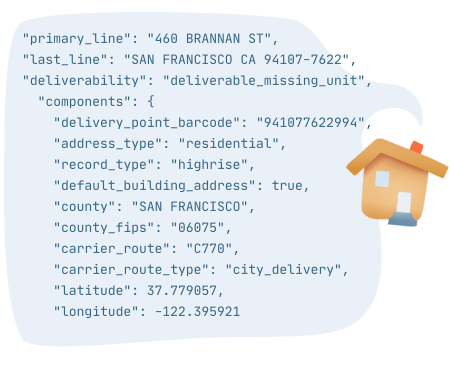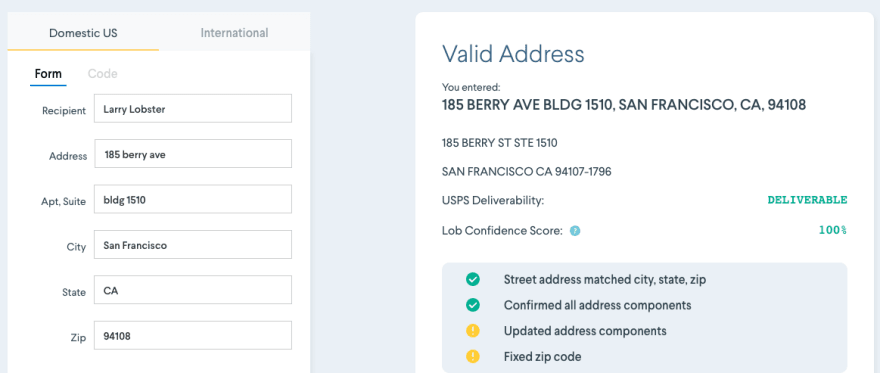The Address Verification team at Lob helps simplify the process it takes to verify and validate addresses. Despite the growing digital presence in our everyday lives, the value of accurate physical addresses continues to increase. Especially in the e-commerce sphere, it’s expensive and time consuming to have incorrect addresses and failed shipments. That’s why our engineers developed an API that's able to correct and identify over 156 million domestic addresses and determine whether or not they are deliverable. Read on to increase your understanding of how Lob's Address Verification API works to help direct mail get delivered to the right address every time.
The Address Verification assembly line
Lob’s Address Verification does much more than spit out a yes or no to whether an address is deliverable or not. We designed an address verification assembly line that will:
- Parse and correct a given address
- Add USPS delivery information
- Cross check with multiple sources of data
- Package all these individual components into a single standard JSON response
- Finish the process in under half a second with a nearly 95% accuracy rate
Parsing and standardization
The first step in our pipeline is to parse and identify what a consumer inputs. We’ve spent a considerable amount of time and effort, and will continue doing so to improve our parsing process. Increasing our ability to parse and decipher user submitted addresses allows us to more accurately create a complete USPS standardized address. This is important as a USPS complete address ensures that deliveries will successfully reach the intended address.
Delivery Point Validation
After parsing and standardizing an address, we supplement our data with a Delivery Point Validation analysis that provides extra insights into why an address might be deliverable or not deliverable. Every unique deliverable address served by USPS has a 12-digit identifier, which includes a 2-digit delivery point and check digit assigned to it by the USPS. These digits help ensure the accuracy and deliverability of a particular address (particularly instances when checking for a valid apartment number on a standardized address).
Serialization
After we parse, standardize, and analyze the deliverability of an address we return a standard JSON response that’s broken up into individual components. One of the most important components is our deliverability analysis. Our deliverability analysis returns one of four possible outcomes, and each outcome lets you know what is likely to happen when you attempt to deliver to an address.
- Deliverable: this address is perfectly valid, or we perfected it by matching it to a single address. Go ahead and deliver.
- Deliverable extra secondary: the building provided exists, but secondary number information (apartment, suite, unit) is invalid. If we remove the secondary information we match to a valid delivery point.
- Missing secondary: the address is deliverable, in theory, but is missing secondary information like a unit designation or apartment number. There’s a chance the mail won’t reach its intended recipient until address completion. This would be like mail reaching the correct apartment building but not reaching the correct apartment.
- Undeliverable: the address as a whole is not deliverable according to the USPS. However, parts of the address, like the street name or ZIP code, could be valid. While this address could be real and exists, it’s very improbable and most deliveries to this address will fail.
How is this different from other address services?
1. Address Verification compared geocoding services
As a developer, I often notice in Stack Overflow and Medium posts that people use Google Places API or Mapbox when working with addresses. However, those services are made for geocoding and mapping purposes and not verifying addresses. They will attempt to find the closest points to a location that may or may not even exist. You might have experienced this if you’ve ever used Uber or Google Maps and you get dropped off several blocks away from your desired destination. At Lob, we focus on providing real existing addresses but also focus on providing analysis into what makes an address real and deliverable.
2. Flexible pricing
One of the main benefits of using the Lob API to handle all your address verification needs are the potential savings. Even if only two percent of all users inputted addresses have some sort of deficiency, that still ends up costing over $200 for every 1000 shipments in redelivery and operation costs. And for larger enterprise customers, that cost can skyrocket into the thousands. We offer various pricing options depending on usage, and each price point is designed to help for different use cases. For smaller businesses and startups we have no upfront costs and only 5 cents per verification after a certain amount of free usage. For enterprise customers, we have solutions that offer over 10,000 address verification requests for only $55 a month and each additional request costs fractions of a cent at $.006 per request.
3. CASS certification
Our address verification service is one of the few that are able to receive a CASS USPS certification that helps us make decisions in correspondence with official USPS address records.
4. Integrations + complementary features
Lob has been building APIs for nearly a decade, and we’ve cultivated over 10 years of customer feedback into our API design. While our API is robust, we also offer additional tools so anyone can use our service without worrying about additional implementation steps.
The list includes:
- Shopify Address Cleanser
- Airtable integrations
- No code and low code verification solutions
- Zapier integrations
- International verifications
- Autocomplete and front end components
5. Lob Confidence Score and Accuracy
Lob's direct mail APIs have access to mailing and address data for 1 out every 2 households in the US; we use all that data to help our internal accuracy measurements, as well as supplement the data we get from the USPS to get more accurate results. We call this our Lob Confidence Score and it can be seen in our response body.
6. Machine learning
Another tool that helps us grow is the machine learning models we deploy to help parse addresses. We use a number of active learning pipelines to train in house deep learning models to help improve our ability to parse addresses.
Conclusion
Addresses are complicated as there are many technical details used to parse them, to determine if they’re real, and why they’re real. The Lob Address Verification team handles it for you and helps reduce costs of returned shipments and redelivery fees. Our domain knowledge is in how addresses work and we offer an API so that you can focus your time and energy elsewhere.
Check out Lob's Address API for yourself here or visit our Postman Workspace.









Top comments (0)